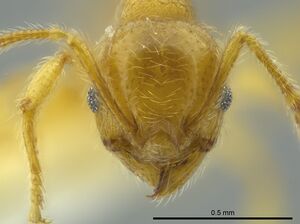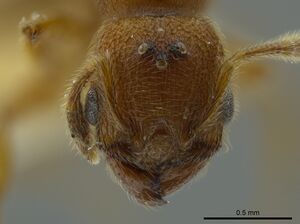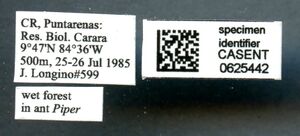Pheidole bicornis
| Pheidole bicornis | |
|---|---|

| |
| Scientific classification | |
| Kingdom: | Animalia |
| Phylum: | Arthropoda |
| Class: | Insecta |
| Order: | Hymenoptera |
| Family: | Formicidae |
| Subfamily: | Myrmicinae |
| Tribe: | Attini |
| Genus: | Pheidole |
| Species group: | transversostriata |
| Species: | P. bicornis |
| Binomial name | |
| Pheidole bicornis Forel, 1899 | |
From Wilson (2003): In Costa Rica at least, P. bicornis is an obligate inhabitant of species of understory rainforest shrubs of the genus Piper. The ants live in cavities of the petioles and stems that they hollow out themselves. The relationship appears to be mutualistic: the workers, which seldom forage on the ground, feed on lipid-rich food bodies developing within the petiolar cavities. For their part the plants evidently benefit from the removal of the eggs and early stages of herbivorous insects (Letourneau 1983), as well as from the clearing of vines and transport of organic material into the plant by the ants during nest construction (Risch et al. 1977).
Identification
See the description in the nomenclature section.
Keys including this Species
Distribution
From Wilson (2003): Costa Rica, Panama. In Costa Rica the species has been found in both the Atlantic and Pacific lowlands (Longino 1997) and to an elevation of 1270m (Risch et al. 1977).
Latitudinal Distribution Pattern
Latitudinal Range: 15.106° to 8.713°.
| North Temperate |
North Subtropical |
Tropical | South Subtropical |
South Temperate |
- Source: AntMaps
Distribution based on Regional Taxon Lists
Neotropical Region: Costa Rica, Panama (type locality).
Distribution based on AntMaps
Distribution based on AntWeb specimens
Check data from AntWeb
Countries Occupied
| Number of countries occupied by this species based on AntWiki Regional Taxon Lists. In general, fewer countries occupied indicates a narrower range, while more countries indicates a more widespread species. |

|
Estimated Abundance
| Relative abundance based on number of AntMaps records per species (this species within the purple bar). Fewer records (to the left) indicates a less abundant/encountered species while more records (to the right) indicates more abundant/encountered species. |

|
Biology
Castes
Worker
Minor
Images from AntWeb
    
| |
| Worker. Specimen code casent0625441. Photographer Jeremy Pilllow, uploaded by University of Utah. | Owned by JTLC. |
Major
Images from AntWeb
   
| |
| Holotype of Pheidole bicornis. Worker (major/soldier). Specimen code casent0901584. Photographer Will Ericson, uploaded by California Academy of Sciences. | Owned by NHMUK, London, UK. |
   
| |
| Lectotype of Pheidole bicornis. Worker (major/soldier). Specimen code casent0908308. Photographer Will Ericson, uploaded by California Academy of Sciences. | Owned by MHNG, Geneva, Switzerland. |
    
| |
| Worker (major/soldier). Specimen code inbiocri001281881. Photographer Jeremy Pilllow, uploaded by University of Utah. | Owned by JTLC. |
Queen
Images from AntWeb
    
| |
| Queen (alate/dealate). Specimen code casent0625442. Photographer Jeremy Pilllow, uploaded by University of Utah. | Owned by JTLC. |
Nomenclature
The following information is derived from Barry Bolton's Online Catalogue of the Ants of the World.
- bicornis. Pheidole bicornis Forel, 1899c: 74, pl. 3, fig. 24 (s.) PANAMA. Combination in P. (Trachypheidole): Emery, 1915i: 190. See also: Wilson, 2003: 641.
Unless otherwise noted the text for the remainder of this section is reported from the publication that includes the original description.
Description
From Wilson (2003): DIAGNOSIS A member of the transversostriata group and evidently close to the tristis group, easily distinguished by its small size; and in the major by the sharp, upturned horn-like extensions of the frontal lobes and heavy rugoreticulate dorsum of the head, broken in the central posterior region by a ladder-like sequence of parallel transverse carinae.
MEASUREMENTS (mm) Lectotype major: HW 0.86, HL 1.08, SL 0.38, EL 0.12, PW 0.54. Minor (San Vito, Costa Rica): HW 0.48, HL 0.54, SL 0.42, EL 0.08, PW 0.32.
COLOR Major: concolorous light reddish brown.
Minor: concolorous yellow.
Figure. Upper: lectotype, major. Lower: minor (Finca Loma Linda, near Agua Buena, Puntarenas, Costa Rica, col. J. Vandermeer). Scale bars = 1 mm.
Type Material
Bugaba, Panama. Musee d'Histoire Naturelle Genève - as reported in Wilson (2003)
Etymology
L bicornis, two-horned, referring to the cornulate extensions of the frontal lobes of the major. (Wilson 2003)
References
- Emery, C. 1915g. Noms de sous-genres et de genres proposés pour la sous-famille des Myrmicinae. Modifications à la classification de ce groupe (Hymenoptera Formicidae). Bull. Soc. Entomol. Fr. 1915: 189-192 (page 190, Combination in P. (Trachypheidole))
- Forel, A. 1899e. Formicidae. [part]. Biol. Cent.-Am. Hym. 3: 57-80 (page 74, pl. 3, fig. 24 soldier described)
- Letourneau, D. K. 1983. Passive aggression: an alternative hypothesis for the Piper-Pheidole association. Oecologia 60:122–126.
- Letourneau D.K. 1998. Ants, stem-borers, and fungal pathogens: experimental tests of a fitness advantage in Piper ant-plants. Ecology 79:593–603
- Risch, S., M. McClure, J. Vandermeer, and S. Waltz. 1977. Mutualism between three species of tropical Piper (Piperaceae) and their ant inhabitants. Amer. Midl. Nat. 98(2): 433–444.
- Wilson, E. O. 2003. Pheidole in the New World: A dominant, hyperdiverse ant genus. Harvard University Press, Cambridge, MA. (page 641, fig. major, minor described)
References based on Global Ant Biodiversity Informatics
- Dattilo W. et al. 2019. MEXICO ANTS: incidence and abundance along the Nearctic-Neotropical interface. Ecology https://doi.org/10.1002/ecy.2944
- Kempf, W.W. 1972. Catalago abreviado das formigas da regiao Neotropical (Hym. Formicidae) Studia Entomologica 15(1-4).
- Longino J. T. L., and M. G. Branstetter. 2018. The truncated bell: an enigmatic but pervasive elevational diversity pattern in Middle American ants. Ecography 41: 1-12.
- Longino J. et al. ADMAC project. Accessed on March 24th 2017 at https://sites.google.com/site/admacsite/
- Sandoval V. E., and G. Zambrano. 2007. Catálogo de las hormigas presentes en el Museo de Historia Natural de la Universidad del Cauca. Taller Editorial de la Universidad del Cauca, Popayán. 60 pp.



